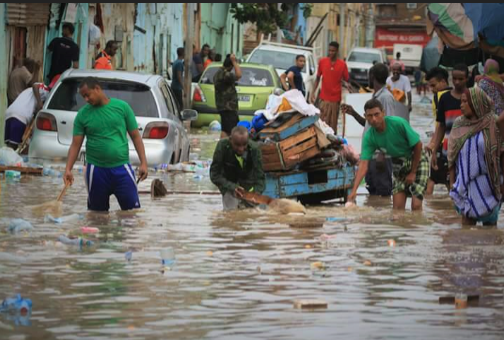 Habitants et véhicules sinistrés dans la banlieue de Balaballa (Djibouti) à la suite des inondations causées par le cyclone Sagar. (Photo : Karima Ben Bih/Banque mondiale)
Habitants et véhicules sinistrés dans la banlieue de Balaballa (Djibouti) à la suite des inondations causées par le cyclone Sagar. (Photo : Karima Ben Bih/Banque mondiale)
In May 2018, tropical cyclone Sagar, accompanied by heavy rains and flash floods made landfall near Djibouti-Ville and its major suburb, Balbala. Three months later, Tunisia was hit by two waves of record-high levels of torrential rain and serious floods. Djibouti was again affected by heavy rains in November 2019 resulting in flash flooding. Faced with these adverse natural events, both the governments of Djibouti and Tunisia requested support from the World Bank in conducting Rapid Needs Assessments (RNAs) or rapid Post-Disaster Needs Assessment (PDNA), which are conducted immediately after the onset of a disaster to evaluate its impacts in the affected areas and the associated recovery needs.
The purpose of the Rapid Needs Assessments or rapid Post-Disaster Needs Assessment is to perform a broad-based assessment that can help governments identify the critical impact and resulting priority needs and interventions in a matter of days instead of conducting a detailed analysis that might take months. Such assessments are government-led with support from international donors, including the World Bank. RNAs and PDNAs rely on data collected locally by the government in the aftermath of the disaster, satellite imagery analysis (if available), as well as percentage-based estimation models in case of access limitations. Governments can use them as analytical basis to prepare emergency budgets to implement priority interventions, to reprogram funds allocated for other development projects, and/or to mobilize additional resources. As the case studies of Djibouti and Tunisia show, RNAs and rapid PDNAs can also be used to raise the awareness of governments on the need to improve their countries’ disaster risk management (DRM) systems.
In Djibouti, the 2018 RNA was conducted with the assistance of the Food and Agriculture Organization. Within one week of receiving the official request, the assessment was completed, and the findings presented to the Ministry of Finance. The assessment estimated that the damages and losses due to Cyclone Sagar amounted to US$ 29 million, and that US$ 31 million was needed for recovery and reconstruction. Within the first year of the disaster, Djibouti’s recovery focus has been placed on restoring vulnerable damaged physical infrastructure in the critical sectors and providing immediate support to farmers and the livelihood of those most affected. Within the next three years, the focus will shift to investing in enhancing disaster risk reduction measures such as improving hydrometeorological early warning systems to alert the community and put in place measures to reduce losses.
Supported by the Global Facility for Disaster Reduction and Recovery (GFDRR), the RNA in Djibouti has also informed a modified institutional framework for national disaster response, which outlines how the government will prepare for, respond to, and recover from disasters, and disaster communication guidelines. As a direct result of the RNA’s findings, the Government of Djibouti is also being supported by the World Bank in exploring viable options for disaster risk financing. Building up on the 2018 RNA, a World Bank-supported rapid Post-Disaster Needs Assessment (PDNA) was carried out jointly with the United Nations after the November 2019 flash flooding. Led by the Ministry of Interior and covering eight sectors, the rapid PDNA found that the housing, transport and health sectors were the most severely affected. The preliminary findings were presented to the Executive Secretary for Disaster Risk Management (DRM) within five days. With additional data collection being undertaken, the final report is currently being completed.
In Tunisia, the RNA was led by the Government with support from the World Bank, the United Nations, and the European Union. A first preliminary report was presented one week following the disaster event to the Ministry of Development, Investment and International Cooperation. This report was then used by the Government for mobilizing funding during the 2018 World Bank Annual Meetings. Following additional data collection on the ground, a final report was presented one month after the flooding. The final report estimated the recovery and reconstruction needs at US$ 99 million, most of them concentrated in the transport and housing sectors that were significantly impacted by the flooding. The RNA identified areas which could be strengthened in the country’s DRM system, including disaster risk understanding, an institutional framework with cross-sectoral coordination, a functioning early warning system, and systematic ex-ante disaster risk financing mechanisms.
Prompted by the analysis provided in the RNA, the Government of Tunisia subsequently requested the World Bank to provide technical and financial support on DRM. Based on detailed consultations with key counterparts, the World Bank is currently providing a comprehensive technical assistance program, which covers the following main elements: i) the development of a national hazard risk profile covering floods and earthquakes, ii) technical inputs to the national flood risk management program; iii) recommendations for the institutional strengthening of Tunisia’s DRM framework; iv) technical support to improve the country’s hydrometeorological services and early warning systems, and v) the development of a national disaster risk financing strategy.
As the two case studies in Djibouti and Tunisia demonstrate, RNAs can be a very useful tool for governments to quickly understand the impact of small-scale disasters and to initiate appropriate disaster recovery efforts. As they also shed light on the underlying challenges in countries’ DRM systems, they also serve as effective instruments to identify areas of collaboration between the governments and the international community, including the World Bank, on strengthening DRM. With the effects of climate change likely to aggravate the frequency and severity of natural disasters in the Middle East and North Africa, demand for this kind of assessments is likely to increase in the near future.




Join the Conversation